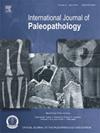A historical case of Eagle’s syndrome from the Constantine-Helena Church, Niğde, Türkiye
IF 1.5
3区 地球科学
Q3 PALEONTOLOGY
引用次数: 0
Abstract
Objective
To evaluate a case of elongated styloid processes in an individual from a Byzantine burial.
Materials
One well preserved adult human skeleton dated to the 7th-9th centuries buried within the church of Constantine-Helena near Niğde in the Cappadocia region of Anatolia.
Methods
Macroscopic and metric analysis using a digital sliding calliper, enhanced and complemented by a Multi-Detector Computer Tomography scan of the cranium.
Results
Individual was estimated to be an old adult male. Total lengths of the left styloid process were 79.0 mm using a calliper and 78.7 mm based on computerised digital measurement. The right styloid process measured 73.0 mm using a calliper and 75.5 mm based on computerised digital measurement.
Conclusions
Bilateral elongation of the styloid processes and Eagle’s syndrome were confirmed based on the lengths of the styloid processes greater than the normal range. The most consistent aetiology of the condition in this instance is anatomic variance.
Significance
Recognising the presence of Eagle Syndrome in the past provides insight into population dynamics and potentially the evolution of this condition.
Limitations
Only a single individual was evaluated without aDNA analysis.
Suggestions for further research
Further analysis and review of skeletal populations, using standardised methods and modern imaging techniques, to identify this condition geographically and chronologically.
鹰综合症的历史案例从君士坦丁-海伦娜教堂,Niğde, trkiye
目的评价一个拜占庭墓葬中出现的茎突拉长的病例。在安纳托利亚卡帕多西亚地区Niğde附近的君士坦丁-海伦娜教堂里,一具保存完好的成人骨骼可以追溯到7 -9世纪。方法采用数字滑动卡尺进行宏观和计量分析,并辅以多探测器计算机断层扫描。结果个体估计为一名老年成年男性。用卡尺测量左茎突总长度为79.0 mm,计算机数字测量为78.7 mm。右侧茎突用卡尺测量73.0 mm,用计算机数字测量75.5 mm。结论以茎突长度大于正常范围为基础,证实了双侧茎突延长和Eagle综合征。在这种情况下,最一致的病因是解剖变异。在过去认识到鹰综合征的存在提供了对种群动态和这种情况的潜在演变的洞察。仅对单个个体进行了评估,未进行aDNA分析。对骨骼种群的进一步分析和回顾,使用标准化方法和现代成像技术,从地理和时间上确定这种情况。
本文章由计算机程序翻译,如有差异,请以英文原文为准。
求助全文
约1分钟内获得全文
求助全文
来源期刊

International Journal of Paleopathology
PALEONTOLOGY-PATHOLOGY
CiteScore
2.90
自引率
25.00%
发文量
43
期刊介绍:
Paleopathology is the study and application of methods and techniques for investigating diseases and related conditions from skeletal and soft tissue remains. The International Journal of Paleopathology (IJPP) will publish original and significant articles on human and animal (including hominids) disease, based upon the study of physical remains, including osseous, dental, and preserved soft tissues at a range of methodological levels, from direct observation to molecular, chemical, histological and radiographic analysis. Discussion of ways in which these methods can be applied to the reconstruction of health, disease and life histories in the past is central to the discipline, so the journal would also encourage papers covering interpretive and theoretical issues, and those that place the study of disease at the centre of a bioarchaeological or biocultural approach. Papers dealing with historical evidence relating to disease in the past (rather than history of medicine) will also be published. The journal will also accept significant studies that applied previously developed techniques to new materials, setting the research in the context of current debates on past human and animal health.
 求助内容:
求助内容: 应助结果提醒方式:
应助结果提醒方式:


